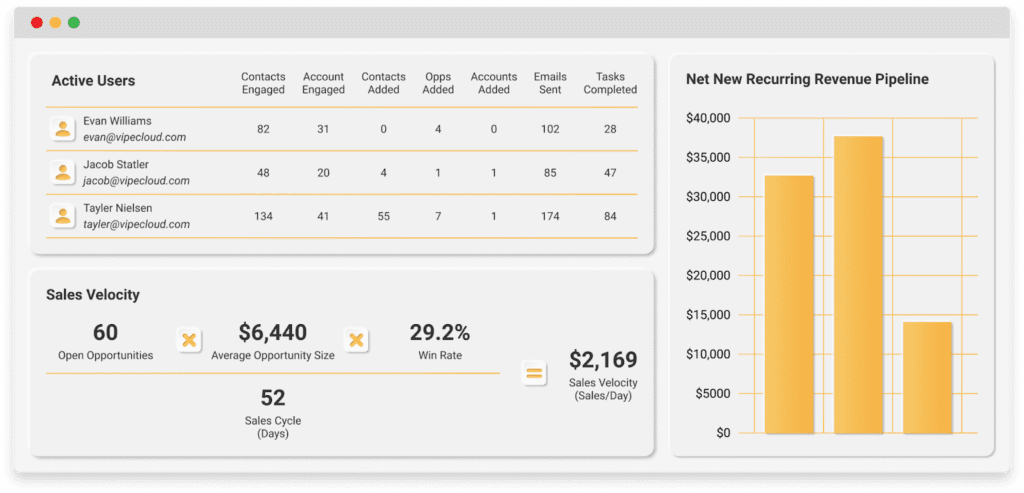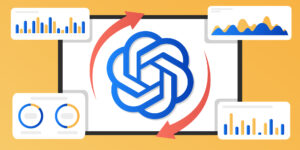Last updated on March 12th, 2024

Sales enablement can make winning deals easier and selling more efficient. Read this guide on finding the best sales enablement tools for your business.
Is your organization reaching a "glass ceiling" when winning opportunities or being more efficient?
This could be due to problems in your sales process.
Luckily, sales enablement exists to fix gridlock so that you can burst through revenue plateaus and make your team better.
In this guide, you'll learn how to invest in sales enablement based on your sales team’s current pain points.
Let's begin.
Table of Contents:
- What Are Sales Enablement Tools?
- Why Your Organization Needs Sales Enablement Tools
- How To Align Your Choice of Sales Enablement Tools With Business Outcomes
- 7 Best Sales Enablement Tools To Consider
- A Final Wrap Up Of Sales Enablement Software
What Are Sales Enablement Tools?
Sales enablement adoption has increased by 343% in the past 5 years.
Why?
Sales enablement solutions make selling more effective and efficient. In other words, they're responsible for giving your team deal leverage.
As you gain familiarity with different forms of sales enablement, you'll find that you can use it to:
- Collaborate across sales teams
- Leverage automation
- Build better customer relationships
- Access key sales insights and data
- Develop team sales skills
- Create better sales content
- Prospect more efficiently
Let's look further into why organizations (small or large) should make sales enablement a foundational piece to their sales success.
Why Your Organization Needs Sales Enablement Tools
Here are three benefits to investing in sales enablement for your organization.
1. Better Understanding Of Customers
Some sale enablement tools help reps gather in-depth information about their customers.
These could be an all-in-one CRM that shows the types of leads in your pipeline, and customer journey history, or a content analytics tool that shows user interactions with different parts of your website.
The information you gather from sales enablement can help you provide better customer experiences in the following ways:
- More personalization
- Better segmentation of your different audiences
- Better sales protocols that heavily consider the needs of your different segments
Understanding your customers and applying the information you know about them also helps your organization stand out from competitors in the market.
2. More Time To Sell
Sales enablement tools can help reduce manual non-revenue generating activities without hurting your operations.
Typically many sales organizations suffer from:
- Tedious manual data entry
- Siloed sales reporting
- Inefficient scheduling
- Spending lot's of time on unqualified prospects
By having more time to sell, there's more deal-winning activity (especially if your team is well trained year-round and stays up to date with product and market changes.).
Remember, time can never be brought back, so giving your team more time to sell is giving them an invaluable commodity.
3. Reduction In Sales Bottlenecks
The start of a successful sales enablement implementation means evaluating your sales process from "prospecting" to Win/Loss.".
In other words, you have to find actions in your sales process that can be improved with sales enablement tools
Because one of the functions of sales enablement is to improve efficiency and remove sales bottlenecks.
For example, let’s say your sales team isn’t generating enough leads that are sales qualified.
As a result, you adopt prospecting software to find decision-makers based on your buyer personas.
Eventually, this leads to more qualified prospects entering your sales pipeline.
This would cause the lead quality “bottleneck” to be improved, which will have a positive trickle-down effect on the rest of your pipeline stages.
How To Align Your Choice of Sales Enablement Tools With Business Outcomes
Here's a 6-step formula for adopting the right sales enablement tools.
1. Take An Inventory Of Current Roadblocks
Start your implementation by outlining the problems occurring in your sales process and why they're there:
- Are deals taking a long time to close?
- Is your sales team engaging contacts enough during follow-up?
- Is lead quality sufficient?
- Is lead volume sufficient?
Using a reporting dashboard is one of the best ways to understand roadblocks accurately.

You can use this tool to track deal activity and internal operations from your CRM suite.
Use this sales data to look for “roadblocks” in each stage of your sales process.
Later, you’ll find suitable sales enablement solutions based off of these roadblocks..
2. Identify Sales Enablement Criteria
Next, identify the criteria you need from your sales enablement tools.
For example, you might want to consider:
- Price
- Integration capabilities
- Ease of use
Knowing your criteria will help you to know what to look for, weed out tools that don't fit, and find those that do.
3. Research Different Solutions Based On Sales Gaps
Once you identify your sales roadblocks and your sales enablement criteria, you can figure what tools will be worth the investment.
Later in this article we’ll go over the most common sales enablement tools that teams use to solve their pain points.
However as you review a tool, you’ll want to take the following into consideration:
- Subject-matter experts — What are the experts in your industry saying?
- Case studies — Is this tool proven to get results?
- Blogs and articles — Can you find reputable review articles?
- Sales training — How difficult will it be to implement the tool among your team?
- Competitor analysis — How does the tool compare to its competitors?
These can all contribute to helpful information, and the more resources you use, the easier it’ll be to decide on your investment.
4. Choose Your Tools
Once you've gathered enough information, consult with your partners, stakeholders, and team members for their opinions:
- What do they think are the biggest problems that can be solved with sales enablement?
- What criteria do they hold as most important?
- What sales enablement tools do they consider most important?
Getting your team’s feedback increases the chance of a tool’s adoption being successful.
5. Measure Their Effectiveness Using Data
After a quarter, consider what changes your new sales enablement solution has made.
For example, if you implemented a learning management system, you can consider:
- Has sales effectiveness improved when you looked at your win rates?
- Is your average sales cycle length (ASCL) shorter?
- Are reps more efficient thanks to learning more better ways to engage contacts?
Measuring your results using CRM data can help you evaluate sales enablement effectiveness.
7 Best Sales Enablement Tools To Consider
1. CRM
Customer relationship management (CRM) is a system that lets you store customer information, communicate with them, and track business KPIs.
Thanks to its versatility, many businesses use all-in-one CRMs as their primary sales enablement tool.
Not only can you track your sales pipeline and automate important sales-related tasks, but you leverage tools like:
- Analytics
- Lead scoring
- Multi-channel selling (email, text, social media)
- Scheduler
- Estimates
- Forms
- Segmentation
VipeCloud is an all-in-one CRM that helps you with all these capabilities, giving reps the ability to generate leads and nurture deals until they close.
Utilizing CRM as your primary sales enablement platform helps cut costs AND eliminates the need to have scattered software across your business ecosystem.

2. Learning Management System (LMS)
Learning management systems help reps sell better by having them take and complete sales training digitally.
You can use this software to create sales training videos and documents to get current and new hires up to speed with how your organization sells.
Sales Tip: Have your training centered around core sales principles such as:
- Sales methodology
- Objection handling
- Sales software utilization
- Product information
- Sales plays
- Sales enablement how-to's
LMS can also be a helping hand as you scale your sales team.
The reason being is because it helps you establish a repeatable training system you can bring your new hires into.
3. Sales Prospecting Software
Let's face it — prospecting can be very manual and take up LOTS of time.
Rather than scouring through social media, websites, and Google for emails and phone numbers, prospecting software brings contact to you directly.
You can find your ideal prospects by gaining their contact information in the software. You can search and filter contacts by:
- Industry name
- Company size
- Job title
- Revenue
- Zipcode
- Country/region
Ideally, you should filter contacts by your buyer persona.
Once done, you'll gain a list of different companies that match your parameters along with the contact information of the people in it.
Prospecting software also lets you export your contacts list and connect it to your CRM to power email and text message campaigns.
This can add tons of efficiency to business development (creating contact lists and generating appointments) and keeps your sales pipeline full.
You can predictably know how many discovery calls, touchpoints, and sales meetings you need to get a new client if you track your sales numbers.
4. Sales Enablement Content
Sales enablement content is internal or external content that can be provided to reps or prospects based on the sales stage.
Externally their role is to provide value and improve the customer experience. They can include:
- Product one-pagers
- Product FAQs
- Case studies
- Competitor comparisons
- Testimonials
- Customer stories
Internally, their role is to keep reps sharp and well trained. Some examples include:
- Sales scripts
- Sales battle cards
- Email templates
- Product overview
- Buyer personas
And much more.
Sales Tip: To be as organized as possible, stores your internal sales enablement content in a digital sales playbook.
The best way to create compelling sales enablement content is for marketing, product, client success, and sales teams to work together.
First and foremost, this collaboration should establish what reps and their prospects need at each stage in the sales cycle to sell more effectively:
- What materials do reps need to convey product information clearly and close more deals?
- What do customers need to know and have a hold of based on where they are in their buying journey?
5. Content Analytics
Content analytics help tracks how leads interact with content on your website or different landing pages.
This tool can come in handy in your top-of-funnel selling and even bottom-of-funnel follow-ups.
Content analytics uses data and heat maps to show where users are clicking, what pages they're visiting, etc.
You can better analyze online sales content and make follow-ups more tailored to the user when you know this information.
By measuring content effectiveness, you can tweak them to provide more valuable customer experiences that’ll increase the odds of at least getting them on a call.
6. Sales Content Management System
A sales content management system is a repository that helps you store sales content (product cheat sheets, case studies, testimonials, etc.) in one software for easy access across your team.
Earlier I mentioned the importance of digitizing your sales playbook for easy accessibility.
Your sales content management system is one of the best ways to do so.
Here are just some of the things you can store:
- Documents
- Videos
- Graphics
- Brochures
Storing your sales enablement components in one system makes training more efficient and keeps your organization more organized (clearly, since team members don't have to look through countless files to find a document!)
7. Sales Presentation Software
Research shows that 65% of the general population are visual learners, meaning they need to see information to retain it.
This is where sales presentation software can make conveying your product value proposition more understandably and easier.
You can take advantage of interactive and tailored presentations that help prospects visually see (through graphs, animation effects, and other imagery) how their problem can be solved with your product.
Here's what you can gain when implementing this as a sales enablement asset:
- Create unique presentations based on prospect desires
- Record presentations
- Share presentation content and track what prospects view and share
- Online and offline viewing capabilities
Having your team conduct sales meetings that stand out can help your offer seem more valuable than other competitors.
Why?
Because you're creating a more memorable and personalized user experience that builds more trust and rapport!
A Final Wrap Up Of Sales Enablement Software
Sales enablement bridges gaps that show up with your customer-facing teams.
By having it present at each stage in the sales process, sales effectiveness and efficiency become a by-product.
First, you must determine what's needed, compare tools, and then choose the best one based on your criteria.
Investing in an all-in-one CRM will be the cornerstone of all of your sales enablement tools.
Thanks to its marketing, sales, and customer relationship-building capabilities, you'll have many assets to make your selling more efficient and effective.
Strengthen sales enablement with VipeCloud's Sales & Marketing Suite by requesting a demo today.
If you'd like to see VipeCloud in action yourself, try it free for 15 days!




Leave a Reply